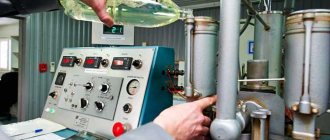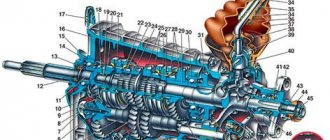The octane number of gasoline indicates its resistance to spontaneous combustion (detonation). The higher the octane number, the higher the knock resistance of gasoline, and vice versa. A high octane number indicates that the fuel can withstand greater compression before detonation occurs. A low octane number indicates a low compressibility of the fuel before spontaneous combustion occurs.
Explanation of the term “gasoline octane number”
The term itself does not reveal what the octane number is, because the standard fuel is a mixture of isooctane (not octane) and n-heptane. These two organic compounds were chosen as reference compounds due to their properties:
- Isooctane will not spontaneously explode even at compression ratios much higher than those created in standard gasoline engines. That is, isooctane without any impurities can be considered gasoline with an RON of 100.
- Even a small compression is enough for heptane to explode spontaneously.
Thus, the octane number is a kind of scale showing the percentage ratio of the shares of isooctane and n-heptane. This definition means that gasoline, designated A-95, will have detonation properties similar to a 95% mixture of isooctane and n-heptane.
Sensitive gasolines
An interesting parameter of gasoline is called “Sensitivity”. It is directly related to octane numbers because sensitivity is the difference between RON and RON. The smaller it is, the higher the versatility of the fuel in terms of detonation resistance under any operating conditions. It is curious that the ancient AI-80 is superior to both AI-95 and AI-98 in terms of versatility.
Sensitivity of main domestic gasolines
| OHM | EYES | Sensitivity | |
| AI-80 | 76 | 80 | 4 |
| AI-92 | 83 | 92 | 9 |
| AI-95 | 85 | 95 | 10 |
| AI-98 | 88 | 98 | 10 |
Sources
- https://autochainik.ru/oktanovoe-chislo-benzina.html
- https://tolkavto.ru/remont-i-obsluzhivanie/toplivnaya-sistema/chto-takoe-oktanovoe-chislo.html
- https://barrel.black/oktanovoe-chislo.html
- https://nefte-gaz.info/oktanovoe-chislo
- https://quto.ru/journal/autorambler/chto-takoe-oktanovoe-chislo-benzina.htm
- https://pobenzinu.ru/benzin/oktanovoe-chislo
- https://oilyug.ru/benzin/oktanovoe-chislo-benzina-chto-eto-takoe-i-na-chto-vliyaet.html
- https://autoexpertjournal.ru/oktanovoe-chislo/
- https://DriverTip.ru/osnovy/chto-takoe-oktanovoe-chislo-benzina.html
- https://CoptersWorld.ru/marki-avtomashin/maksimalnoe-oktanovoe-chislo-benzina.html
[collapse]
What is "detonation"
Spontaneous, uncontrolled combustion of fuel in an engine is called “detonation.” This is one of the dangerous processes, as a sharp increase in temperature and explosion occurs (the combustion speed increases from 15 m/s to 1.5 km/s).
Detonation provokes coking of the combustion chamber, the formation of shock waves, overheating, and, as a result, rapid engine wear due to uncoordinated operation of the mechanisms.
This process can be triggered by using fuel with a lower octane rating than that recommended by the manufacturer. This may also be caused by purchasing low-quality gasoline, which contains easily evaporated substances.
During stable operation of a gasoline engine, the fuel is ignited by a spark when the piston is almost at top dead center. In the case of detonation, this process occurs during the compression stroke, causing resistance to the movement of the piston, which leads to overheating, reduced power, and increased engine wear.
The causes of detonation can vary, but one of the most common is the use of gasoline with a lower octane rating than recommended for a particular engine type.
Powerful internal combustion engines are designed for a high degree of compression of the fuel-air mixture. And if a car that can only be used as fuel with 95 octane gasoline is filled with fuel with an octane rating of 80, detonation will be observed when the engine is running under load.
However, the use of fuel with the required octane number does not guarantee the absence of detonation. The fact is that unscrupulous gasoline manufacturers can use low-quality additives to artificially increase the octane number. Some of these additives, such as methane and propane, are volatile and quickly evaporate from the fuel, resulting in a decrease in octane number.
With normal smooth combustion of fuel in a cylinder, the flame front moves at a speed of 20-40 m/s, which allows the gasoline to burn completely. During detonation, the speed of the flame front increases to 2000 m/s, which is similar to an explosion.
Hypersonic shock waves tear off the oil film on the walls of the liners, which increases wear on the piston rings and cylinders, and the engine overheats.
Detonation is expressed in the appearance of characteristic metallic knocks (impacts of a blast wave on the cylinder walls in the engine), overheating and loss of engine power. Detonation leads to coking of the combustion chambers and rapid engine wear due to malfunctioning mechanisms. This is an extremely negative and dangerous phenomenon that is best avoided.
Causes of detonation
Detonation can occur when using gasoline with a lower octane rating than that recommended by the engine manufacturer, for example, using 80-octane gasoline in an engine designed for 95-octane gasoline. And also when using low-quality gasoline with easily evaporated components.
Methane or propane can be added to such gasoline as additives, which evaporate very quickly, thereby reducing the octane number of gasoline.
Different substances have their own resistance to detonation, some more resistant than others. Thus, heptane is unstable to fire, while isooctane is stable. Therefore, gasoline that is more resistant to detonation contains a small amount of heptane and a large amount of isooctane.
Detonation can also be triggered by an unjustified increase in engine speed, incorrect mixture composition, incorrectly adjusted ignition timing, etc. But all this does not apply to the quality of gasoline, and the engine of a modern car is designed so as not to create problems out of the blue.
The main reason for detonation is the discrepancy between the detonation resistance of gasoline and the compression ratio of the engine, that is, the ratio of the free volumes of its cylinders at the bottom and top dead centers.
The higher the compression ratio, the more efficiently the engine operates, the more power can be obtained per unit cylinder volume. Therefore, the compression ratio of modern engines is quite high. But the higher it is, the stronger the gasoline detonates.
General concept
The combustible mixture of fuel and air is compressed in the cylinder before ignition. Moreover, the compression ratio depends on the engine design and is in the range of 7–10. An important point: gasoline must ignite at a certain moment when a spark discharge is applied to the spark plug electrodes.
Reference. It's worth clarifying what engine compression ratio means. This is a figure showing how many times the combustible mixture is compressed before ignition. It is calculated simply: the total displacement of the cylinder is divided by the volume of the combustion chamber. In old engines this figure is 7, in more modern engines it reaches 9–10.
If the air-fuel mixture ignites prematurely during piston compression (as in a diesel engine), the following will happen:
- Self-ignition of gasoline causes a micro-explosion - burning at too high a speed.
- The flash energy propagates in two directions - towards the piston and the combustion chamber.
- Since all the valves are closed, the shock is reflected from the walls and hits the piston, which continues to move upward. There is a loud metallic knocking sound from the piston pin.
The octane number of gasoline characterizes its resistance to detonation and is defined as the percentage ratio of the mixture of two hydrocarbons included in the fuel:
- isooctane, practically incapable of spontaneous combustion at high pressure;
- n-heptane, on the contrary, flares up under slight compression.
The detonation characteristic of isooctane is assumed to be equal to 100 units, n-heptane - zero. The greater the proportion of the first substance, the higher the resistance of the fuel to self-ignition during compression.
The maximum octane number of 98 units in the gasoline marking means the greatest resistance to detonation. This fuel is intended for engines with the highest compression ratio - 10. Accordingly, grade 95 fuel is suitable for engines that compress the mixture 9 times (the vast majority of these). Obsolete versions of power units with a compression ratio of 8 use A-92 gasoline.
The letter “and” in the letter part of the AI-95 gasoline marking means that the octane number was measured using a research method.
Maximum octane number of gasoline
The development of internal combustion engine technology is moving along the path of increasing power and increasing efficiency. As these parameters increase, the requirements for the fuel used increase.
The use of additives based on organometallics (tetraethyl lead, ferrocene, etc.) makes it possible to obtain gasoline with a knock resistance of 130-140 units. However, in most developed countries, such additives to automobile fuel are prohibited for environmental reasons.
Unleaded (tetraethyl lead-free) gasoline can have an octane number of up to 109 units. Most modern cars are designed to use 95 or 98 octane gasoline.
Racing cars use fuel with a higher octane number - up to 102 (according to FIA technical regulations). The highest octane number of gasoline is typical for some types of aviation fuel - up to 115.
Is it possible to mix 92 and 95 gasoline? What consequences?
Modern oil distillation technology allows you to immediately obtain 92-grade gasoline. 95 differs from it in the presence of light ether additives. Accordingly, gasoline with a higher octane number has a lower specific gravity. When two types are mixed, fuel is formed with a certain average indicator of detonation resistance. However, if you leave the car parked, the gasoline will separate. At the bottom of the tank, near the intake pipe of the fuel pump, there will be a heavy 92, and at the top - a 95. As a result, the engine will first produce low-octane fuel and then high-octane fuel . In the situation with 92 and 95, this will not cause much harm to the engine.
It’s worse when motorists try to “reach” the octane number of 80 to 92 in this way. In this case, after separating the fractions, the engine has to run at 80.
Given the small difference in the cost of fuel with different octane numbers, attempts to mix them are not economically justified.
Recommended octane number for the car
The question of which fuel is best to use for a car can be given a definite answer - the one prescribed for a specific type of engine. The use of low-octane gasoline, as mentioned earlier, will lead to detonation.
Many modern cars are equipped with anti-knock systems, so they can consume fuel with an octane rating lower than the recommended one. But at the same time, fuel consumption increases and engine power decreases, which makes trying to save in this way pointless.
However, using fuel with an octane number exceeding the recommended one will not be beneficial. At best, this will result in increased costs due to the higher cost of high-octane fuel. At worst, incomplete combustion of gasoline may occur.
Other fuel additives
To inhibit oxidative reactions, antioxidant additives are introduced into gasoline, which can be wood resin, which is a mixture of phenols with oils, paraoxyphenylamine and FCh-16, which is a mixture of phenols.
Anti-icing additives are used to prevent carburetor icing. They use compounds that dissolve water and form low-freezing mixtures with it, as well as forming a shell on ice particles, preventing them from growing and settling on the carburetor walls.
Various detergent additives can be used to remove deposits.
Methods for determining octane number
Officially, in Russia, the octane number is measured in two ways - “research” and “motor”. These methods involve the use of specialized installations based on single-cylinder engines with the ability to control the compression ratio and temperature of the fuel mixture. The algorithms for measuring detonation resistance for these methods are the same.
Gasoline samples are compared with reference mixtures. The objective of the study is to select a standard that will detonate with the same intensity as the fuel under study.
The difference between these methods lies in the operating modes of the installations in which the detonation resistance is studied. The “motor” method involves studying gasoline under conditions of maximum engine power at an increased temperature of the injected fuel-air mixture.
During the test, the engine speed is 900 per minute, the temperature of the injected fuel-air mixture is 149 °C. It is conventionally believed that this mode of engine operation is typical for driving a car outside the city.
The “research” method makes it possible to determine the octane number of gasoline at partial engine load. The revolutions are set at 600 per minute, the injected fuel temperature is 52 °C. This mode of operation imitates the movement of a car in the city.
The values of research and motor octane numbers, as a rule, do not coincide. The difference between them is called fuel sensitivity. In this regard, when choosing fuel, it is necessary to pay attention to the method by which detonation resistance was determined. In addition, fuel labeling may vary from country to country.
For example, in Europe the main indicator is RON. In the USA and Canada, another parameter is common - AKI - the average value between research and motor octane numbers.
Due to the fact that the equipment operating manual specifies the requirements for gasoline with the markings of the country of origin, the owner of a foreign-made car should use octane number tables to select the most suitable fuel.
The above methods for determining detonation resistance are labor-intensive and require specialized equipment and reagents. At the same time, many car enthusiasts are interested in the question of how to check the octane number of gasoline at home. In this regard, the method of expressly assessing the octane number using so-called “octane meters” has become widespread.
These devices measure the dielectric constant of gasoline and compare the resulting value with a database stored in the device’s memory. However, this method is not highly accurate, since the readings of the device are highly dependent on the type of fuel additives used by gasoline manufacturers.
In general, the octane number is one of the most difficult to determine gasoline parameters. Standard arbitration methods for its quantitative assessment involve very expensive motor tests on stationary bench installations, produced in only four countries (USA, Russia, Germany, China) and inaccessible to the mass consumer.
How to determine the octane number of gasoline yourself
The octane number can be determined using a special device - an octane meter, which gives a very approximate reading with a large error (5-10 units). It can be purchased freely, but it will not give an exact answer to the question about the octane number of gasoline.
The operating principle of the octane meter is based on measuring the dielectric constant of gasoline and calculating the octane number using the calibration dependence. Therefore, we can say that the octane meter does not measure the octane number, but the impedance electrical conductivity of gasoline, which depends on the amount of high-octane hydrocarbons.
It’s easier to say that it’s impossible to accurately measure the octane number of gasoline yourself.
The most popular octane meters: OKTIS, OCTANOMETER PE-7300M, OKTAN-IM, Digatron, SHATOX SX-100M.
Educational program from "Gorynych"
Just about the complicated stuff:
Today we will talk about an important indicator that characterizes certain properties of fuel.
When purchasing a car, you probably paid attention to what type of fuel the manufacturer recommends to refuel this particular car. And you wisely follow this recommendation, choosing at the gas station the column where the type of gasoline is indicated with the “cherished” numbers - 92, 95, 98
You know that choosing a figure lower than recommended is fraught with danger. A larger one is unreasonably expensive. What kind of numbers are these and why in this case should you listen to the recommendations of car manufacturers?
There are several types of gasoline. Moreover, each of them has its own number corresponding to its octane number. Cars of different brands should be filled with gasoline that is suitable for them. But what is this notorious “octane number” of gasoline? By compressing, all types of fuel resist spontaneous combustion. And the quality of gasoline is higher, the better the fuel “turns out.” In smart language, this property of fuel - to resist spontaneous combustion - is called “knock resistance”. The whole process takes place in the car engine, in the internal combustion chamber. And if gasoline “knows how” to resist self-ignition during compression quite well, the fuel burns normally in any mode of operation of a car engine. In this case, it is possible to avoid oxidation, which can lead to a thermal explosion.
The ability of a fuel to resist spontaneous combustion can be measured. They do this using a special indicator - the same one that is called the tricky phrase “octane number”.
Where does the “octane number” come from?
Isooctane is an organic compound that is found in small quantities in any gasoline. Even strong compression oxidizes it with difficulty. Therefore, its ability to resist self-ignition (detonation resistance) was estimated at 100 units. The resistance to self-ignition of its antipode - n-heptane - is “zero”. By dividing the “stable” isooctane by the “zero” n-heptane, we get a certain indicator in percentage terms, which is usually called the “octane number”. Know-It-All Wikipedia defines octane number as “an indicator characterizing the knock resistance of fuel (the ability of the fuel to resist self-ignition during compression) for internal combustion engines.”
What does it affect?
When a car is “on,” the fuel in its engine is mixed with air and ignited by a spark in the combustion chamber. If this mixture does not resist spontaneous combustion, an explosion occurs, which is not good for your car's engine. In this case, the blast wave, spreading through the engine, enters the exhaust system. As a result, the engine overheats, the gaskets on the cylinder heads are damaged, the pistons and exhaust valves burn out. As a result, the car requires repairs, often quite expensive. By producing engines with a high compression ratio (mainly for luxury cars and sports cars), automobile concerns “insure” you against such troubles. Such engines need a kind of menu in the form of gasoline with a higher octane number as a “main course”.
How to increase the octane number of gasoline?
When leaving the factories, the octane number in gasoline is no more than 70%. To improve it, the fuel is “polished” with various additives. Hydrocarbons with a pungent odor added to gasoline: - reduce oxidation; — prevent detonation; — reduce the content of harmful impurities (water, sulfur). It turns out that high-octane fuel is smellier, but also healthier for your car's heart. It is not the smell that determines the quality of the fuel, but a specific indicator, the compliance of which can be checked using a special device - an octane meter - or in a specialized laboratory. However, there is absolutely no need for drivers to do this. After all, at our gas stations, the octane number of gasoline exactly corresponds to its ability to resist self-ignition, that is, “knock resistance.” “The Serpent Gorynych,” even though he is a fairy-tale character, doesn’t like to joke with such things.
Octane number in gasoline labeling
Motor gasoline is marked with the letter “A,” in contrast to aviation gasoline, which is designated “B.” The letter “I” denotes the octane number, which is obtained by a laboratory research method.
Gasoline is labeled in laboratories where the mixture being tested is compared with a reference sample. Gasoline, which contains 95% isooctane and 5% heptane, is labeled AI-95. The number 95 indicates the percentage of stable isooctane in gasoline.
Gasoline of various brands (AI-92, AI-95, AI-98, extra-, euro-) not only has a different octane number, but also differs in production features, the presence of anti-knock additives and various additives.
How is modern gasoline produced anyway?
Gasoline is a petroleum product consisting of hydrocarbons with admixtures of sulfur, nitrogen, and oxygen-containing compounds. The most important task in production is to achieve a balance of light and heavy fractions of hydrocarbons, on which the volatility of the fuel depends.
The simplest and most archaic method of producing gasoline is direct distillation. Oil is heated to separate light fractions (light hydrocarbons) from heavy ones - they evaporate and fall out as condensate. Direct distillation from a liter of oil usually produces only 150 ml of gasoline with a low octane rating of up to 65 units. To obtain AI-92 from it, the semi-finished product is diluted with additives that increase the octane number. But even with the addition of additives, the quality of such fuel leaves much to be desired.
Large refineries have switched to multi-stage production. In Kazakhstan, fuel is produced at three main refineries using catalytic cracking and reforming technologies. The octane number and quality of gasoline are significantly higher than in the first case. For example, the reforming process can increase the octane number of a petroleum product to 97-98 units according to the research method. But fuel additives are still needed.
Combustion of gasoline with different octane numbers
The rate of fuel combustion directly depends on the octane number. During normal engine operation, the gasoline inside the cylinders should burn gently and gradually and not explode. With this combustion mode, the engine runs smoothly and evenly.
When using low-octane gasoline, the compression ratio in the cylinder exceeds the maximum value and the fuel mixture spontaneously ignites, that is, it detonates before the spark plug has time to produce a spark.
When using high-octane gasoline, the compression ratio of the fuel mixture in the cylinder does not reach the required value at which uniform combustion of fuel occurs. The gasoline will burn too slowly and will not have time to burn out completely.
From the practice of using thermal power plants
Motorists with significant driving experience are familiar with “red candles”. The coloring of the candles in this color occurred when a pure anti-knock agent was added to low-octane gasoline instead of thermal power plants with vents. This led to lead contamination of these devices. After this, it is no longer possible to repair and restore the spark plugs. Thus, the knock resistance of gasoline is characterized not by thoughtless, but by the correct use of anti-knock agents specially designed for this.
Leaded gasoline contributes to less wear on the camshafts, compared to the use of gasoline without TES. It is assumed that the products formed as a result of combustion entered the surface through the oil, which protected it from wear. The latter also decreased in relation to other engine parts when using leaded gasoline.
How does gasoline with a lower octane number affect the engine?
If for some reason you fill your car with gasoline that has an octane rating lower than that recommended by the engine manufacturer (for example, use AI-92 instead of AI-98), this will not lead to anything good for the engine.
When running on low-octane gasoline, detonation occurs in the cylinders, that is, self-ignition, before the spark plug ignites the fuel mixture.
After some time of using the car, extraneous sounds will appear coming from the engine, its power will decrease, and gasoline consumption will increase. The engine temperature will increase, which will increase the temperature in the exhaust catalyst, which will lead to a decrease in its strength.
In such a situation, while driving, it is important not to allow the engine speed to increase; At the nearest gas station you need to fill up with the right brand of gasoline.
Sometimes low-octane gasoline is poured in an attempt to save money, since modern cars are equipped with systems that allow them to cope with such fuel. But, unfortunately, increased fuel consumption nullifies such an experiment. There will be no savings, and the load on the engine will increase.
The influence of the engine rating on the characteristics of the power unit
The relationship between the combustion rate of gasoline and the OS is linear. The lower the octane number, the less time it takes to ignite the fuel assembly, which directly affects fuel consumption - if it burns faster than it should, then it enters the combustion chamber at a speed increased by the corresponding value. But this does not mean that by simply increasing the engine speed, we can save: if combustion occurs more slowly than it should, this is also bad, since the engine efficiency decreases, which leads to a loss of engine throttle response and a deterioration in dynamic characteristics. By filling an engine running on 95-octane gasoline with fuel with an octane rating of 92, you will get an increase in consumption. If the situation is the opposite (instead of the working 92 we fill in the 95), the consumption will remain the same, but the engine power will decrease. So using the wrong gasoline is possible, but not advisable. It is recommended to do this only under force majeure circumstances, but not on a regular basis.
How does gasoline with a higher octane number affect the engine?
Contrary to popular belief that gasoline with a higher octane rating is higher quality and therefore always better, this is not true. If you fill your car with gasoline with an octane rating higher than the recommended one (for example, fill in AI-98 instead of I-92), this also does not bring anything good for the engine.
Running the engine on such gasoline also leads to an increase in fuel consumption, a decrease in power, and the formation of carbon deposits on spark plugs, pistons and valves.
The use of high-octane gasoline implies a higher degree of compression in the cylinders for the normal combustion process of the mixture. An engine that is not designed for such compression will burn fuel too slowly. Gasoline will not have time to burn completely.
Which will further lead to overheating of the exhaust valves. If they burn out, the engine will need to be overhauled, which will take a lot of time and money.
To avoid the negative effects of driving on gasoline with an octane rating higher or lower than the recommended value, it is best to use gasoline that is suitable for your engine.
The main conclusion about the effect of the octane number of gasoline on fuel consumption can be expressed as follows: if the octane number is lower than required, then fuel consumption will increase; if higher, it will remain unchanged.
Compression ratio and RH
All possible types of gasoline are characterized by a very specific compression ratio, which is regulated by GOST. You can see the correspondence of the octane number to the compression ratio from the following table:
| Gasoline name | VERY | GOST | Compression ratio | |
| EYES | OHM | |||
| A72 | 72 | 208477 | 7.00 | |
| A76 | 76 | 208477 | 7.50 | |
| AI80 | 80 | 76 | 5110597 | 8.00 |
| AI91 | 91 | 82.5 | FS 5110597 | 9.00 |
| AI92 | 92 | 83 | TU 38001168/97 | 9.20 |
| AI93 | 93 | 85 | 208477 | 9.30 |
| AI95 | 95 | 85 | FS 5110597 | 9.50 |
| AI96 | 96 | 85 | TU 38001168/97 | 9.60 |
| AI98 | 98 | 87 | FS 5110597 | 10.00 |
Use of gasoline with an inappropriate octane number for the engine
Use of low octane gasoline. If it turns out that you filled the car with low octane fuel, then listen to the engine. If the engine runs stably but pulls poorly, there is nothing to worry about, just burn all the low-octane gasoline and then refill with gasoline with a standard octane number. At the same time, try to avoid dynamic driving to avoid detonation in the engine. But if ringing sounds are heard from the engine, which are often confused with the knocking of valves, then this means that the mixture detonates before the valves close. In fact, this blast wave spreads through the engine block and into the exhaust system. In this case, this can lead to burnout of the pistons and exhaust valves; the fact of the negative impact will be present. “Natural” detonation can sometimes be observed in cases of excessive engine load, when climbing a hill, or when driving in high gear. Prolonged operation of the engine, even with “natural” detonation, is unacceptable, as this can lead to engine overheating and, as a result, damage to the cylinder head gasket, burnout of pistons and valves.
How to lower the octane number of gasoline
Recently, gasoline with an octane rating of 76 and 80 has disappeared from gas stations. But at the same time, a large amount of equipment that is still in use requires this type of fuel for its normal operation. Such difficulties arise especially often with walk-behind tractors produced about 10 years ago or more. Buying a new one is quite an expensive undertaking. That is why the question of reducing the octane number of gasoline is very relevant.
When filling with 92 gasoline instead of 80 or even 76, the engine usually runs unevenly, or starts and immediately stalls. Therefore, before using 92, you should lower its octane number to an acceptable one in a particular case. There are several “folk” ways to carry out this procedure at home: leave a can of gasoline in the open air with the cap unscrewed - every day the octane number decreases by 0.5; use kerosene as an additive - this method was previously used on old cars (it will be quite difficult to choose the appropriate proportions). Moreover, before using this method, it will be necessary to measure the octane number.
Use of high octane gasoline
There is no need to try to use high-octane gasoline for cars whose engines are not designed for it. The disadvantages of this application are also obvious, if the design was originally designed for low-octane gasoline and you used high-octane gasoline, then this will entail a complete reconfiguration of the intake and exhaust gases and possibly the replacement of some engine components. The burning time of gasoline in this case is longer and in fact it will be necessary to adjust the piston group and inflammation in such a way that the expansion of the volume of the cylinder - piston is equal to the burning time, while the valves are closed. In fact, on a tuned engine, gasoline burns out late, and there will also be a loss of power.
How to increase your octane number yourself
The increase in detonation resistance in industrial conditions occurs as follows:
- The technological process is changing: rhenium-based catalysts are added to the composition. This stage increases the number of branched elements, increasing the OR.
- The composition changes: detonators are added to the original form of fuel.
However, you can adjust fuel performance at home by using additives to increase the octane number:
- Octane Plus Hi Gear – 5-6 units;
- Octane Plus Liqui Moly – 2–5 units;
- Astrohim Octane Plus – by 3–5 units;
- Lavr Next Octane Plus – up to 5-6 units;
- Totek UMT (Russian production).
When using gasoline additives yourself, you should remember that they affect not only the resistance of the fuel mixture to detonation, but also other technical characteristics of gasoline and engine performance.
Cetane number of diesel fuel
Gearbox ratio: what it means and how to calculate it
It is the main characteristic of the flammability and combustion of diesel fuel in the engine. The higher it is, the calmer and more complete the fuel mixture burns out.
In numerical terms, this indicator is comparable to the volume fraction of cetane in a specially prepared mixture. This mixture consists of hexadecane and α-methylnaphthalene with the same lag period as the test fuel.
For standard engines, diesel fuel is considered optimal, the cetane number of which varies from 40 to 55. Diesel fuel with a cetane number from 51 to 55 units is considered the highest quality. Premium diesel fuel is lighter, it contains flammable fractions that help the engine start quickly at sub-zero temperatures. When using it, the smokiness is noticeably reduced.
The cetane number of diesel fuel depends on what paraffins, aromatics, olefins and naphthenes are included in its composition. For measurements, use a standard Waukesha power unit or IDT-90. An alternative could be a chamber with a constant volume; testing with this method, unlike the first, takes no more than 20 minutes.
FuelEXx Diesel is recognized as an effective way to increase. It increases this indicator by 3–5 units. At the same time, water is removed from the fuel, the piston rings are decarbonized, and the combustion chamber is cleaned. This has been confirmed by bench and road tests.
How to lower octane number
To reduce the octane level of gasoline, the following methods are used:
- The easiest method is the natural evaporation of volatile high-octane additives. You need to open the fuel container and wait. The octane number decreases at an estimated rate of 0.5 units per day.
- Adding kerosene. A faster, but more complex method, since it is difficult to calculate the required proportion of kerosene so that the octane number does not decrease too much.
Modern methods of oil refining make it possible to obtain high-octane fuel without adding toxic chemicals that pollute the environment.
It should be remembered that high-octane gasoline is not always good. Fuel should not harm the car engine, so it is better to use gasoline recommended by the manufacturer of a particular car brand.











